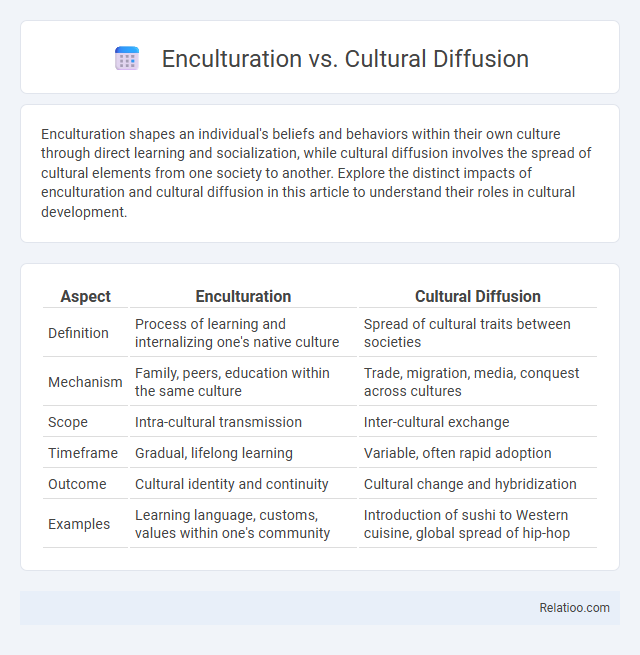Enculturation shapes an individual's beliefs and behaviors within their own culture through direct learning and socialization, while cultural diffusion involves the spread of cultural elements from one society to another. Explore the distinct impacts of enculturation and cultural diffusion in this article to understand their roles in cultural development.
Table of Comparison
| Aspect | Enculturation | Cultural Diffusion |
|---|---|---|
| Definition | Process of learning and internalizing one's native culture | Spread of cultural traits between societies |
| Mechanism | Family, peers, education within the same culture | Trade, migration, media, conquest across cultures |
| Scope | Intra-cultural transmission | Inter-cultural exchange |
| Timeframe | Gradual, lifelong learning | Variable, often rapid adoption |
| Outcome | Cultural identity and continuity | Cultural change and hybridization |
| Examples | Learning language, customs, values within one's community | Introduction of sushi to Western cuisine, global spread of hip-hop |
Defining Enculturation and Cultural Diffusion
Enculturation is the process through which individuals learn and internalize the values, norms, language, and customs of their own culture, typically through family, education, and social interactions from a young age. Cultural diffusion refers to the spread of cultural elements, such as ideas, practices, technologies, and artifacts, from one society or cultural group to another, often resulting in cultural blending or transformation. Understanding both concepts highlights the contrast between internal cultural development and the external transmission of cultural traits across different groups.
Core Differences Between Enculturation and Cultural Diffusion
Enculturation is the process by which individuals learn and adopt the values, beliefs, and norms of their own culture through direct immersion, while cultural diffusion involves the spread of cultural elements between different societies, leading to changes in cultural practices. Your understanding of cultural adaptation hinges on recognizing that enculturation is an inward, generational transmission within a culture, whereas cultural diffusion is an outward, cross-cultural exchange. These fundamental differences highlight enculturation's role in cultural identity formation, contrasting with diffusion's impact on cultural diversity and hybridization.
Processes Involved in Enculturation
Enculturation involves the gradual process of learning and internalizing the norms, values, language, and customs of one's own culture through direct interaction with family, peers, and community from an early age. This lifelong acquisition process shapes individual identity and social behavior by embedding cultural knowledge via observation, imitation, and formal instruction. Unlike cultural diffusion, which refers to the spread of cultural elements between societies, enculturation centers on the transmission and reinforcement of culture within a specific social group.
Mechanisms of Cultural Diffusion
Mechanisms of cultural diffusion include direct contact, such as trade, migration, and intermarriage, which facilitate the transfer of cultural traits between societies. Other mechanisms involve indirect contact through media, technology, and the internet, allowing ideas, customs, and innovations to spread rapidly across global populations. These processes differ from enculturation, which is the internalized learning of culture within a specific society, emphasizing how individuals acquire their native cultural norms.
Role of Family and Education in Enculturation
Enculturation primarily occurs through the family and educational systems where children learn cultural norms, values, language, and social behaviors directly from parents, relatives, and teachers within their community. Unlike cultural diffusion, which involves the spread of cultural elements between different societies often through trade, migration, or media, enculturation is the internal process of cultural transmission within a specific group. Both family and education serve as foundational institutions in enculturation, shaping individual identity and social integration by passing down customs and collective knowledge essential for cultural continuity.
Agents Influencing Cultural Diffusion
Cultural diffusion is primarily influenced by agents such as media, trade, migration, and technology, which facilitate the spread of cultural elements from one society to another. Unlike enculturation, where individuals internalize their own culture through family and community, cultural diffusion involves external agents that introduce new customs and ideas. Your understanding of cultural dynamics deepens by recognizing how these agents actively shape cultural exchange across regions.
Examples of Enculturation in Daily Life
Enculturation is demonstrated when children learn language, customs, and social norms from their families and communities, such as celebrating cultural holidays or adopting traditional dress. Cultural diffusion differs as it involves the spread of cultural elements like cuisine or technology between societies, such as sushi becoming popular worldwide. In contrast, acculturation occurs when individuals or groups adopt aspects of another culture while retaining their original cultural identity, evident in immigrant communities balancing native traditions with new societal practices.
Case Studies of Cultural Diffusion Across Societies
Case studies of cultural diffusion reveal how ideas, customs, and technologies spread from one society to another, shaping cultural landscapes globally. Your understanding of societal change is deepened by examining examples such as the Silk Road facilitating trade and exchange between Asia and Europe, or the spread of agricultural practices across continents. Enculturation, by contrast, involves individuals internalizing cultural norms within their own society, highlighting the difference between adopting shared culture from within and acquiring new elements through external contact.
Impact on Identity and Social Integration
Enculturation shapes identity by embedding cultural norms and values from birth, fostering a strong sense of belonging and continuity within a specific community. Cultural diffusion introduces diverse cultural elements through contact, which can enrich or challenge existing identities, leading to hybridization or cultural adaptation. Social integration depends on the balance between maintaining core cultural traits through enculturation and adapting to new influences via diffusion, influencing group cohesion and individual identity formation.
Contemporary Challenges and Future Trends
Enculturation, cultural diffusion, and acculturation each play significant roles in shaping individual and group identities amid globalization and technological advancements. Contemporary challenges include the erosion of indigenous cultures through dominant cultural influences and the digital divide impacting access to cultural narratives. Future trends suggest increased hybridization of cultures facilitated by social media platforms and virtual reality, promoting both preservation and transformation of cultural practices.

Infographic: Enculturation vs Cultural Diffusion
 relatioo.com
relatioo.com